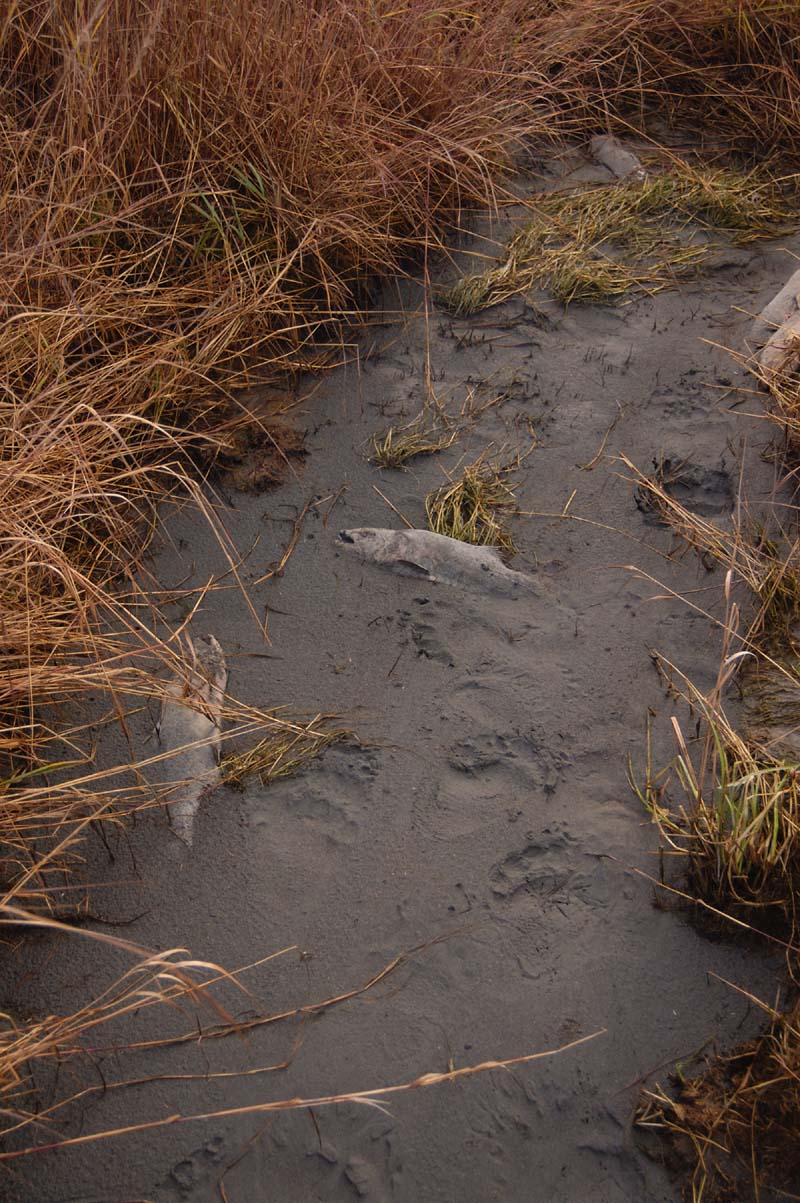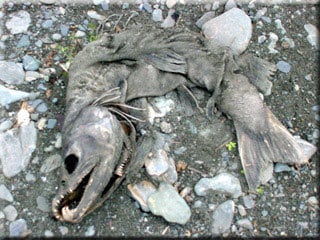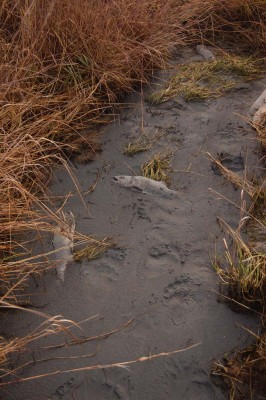
26 Jan Dead salmon mean life
Dead Fish Mean Life for Alaska Rivers and Lakes
Recent study uncovers 300 year history of salmon
 Salmon runs are notorious for being cyclical in nature. Returns can vary greatly from year to year and despite admiral efforts, state agencies have been unable to accurately predict what will happen once the snow melts and the season’s salmon hit the rivers.
Salmon runs are notorious for being cyclical in nature. Returns can vary greatly from year to year and despite admiral efforts, state agencies have been unable to accurately predict what will happen once the snow melts and the season’s salmon hit the rivers.
It seems that boom and bust years in salmon production have been occurring for as long as salmon have existed. At least for the past 300 years, says Bruce Finney, an associate professor of Marine science at the University of Alaska, Fairbanks. His research links swings in salmon populations to changes in the earth’s climate and also magnifies the importance of dead salmon to the abundance and ultimate survival of young salmon.
Finney and several associates studied sockeye salmon since they rear and spawn in lakes and the lakes sedimentary records could be used much like the growth rings of a tree. Taking core samples from some 50 Alaska lakes, the team dated layers and compared the same layers to neighboring lakes that were isolated from salmon runs. They found the isolated lakes had very consistent and unchanging sedimentary patterns where as the salmon lakes revealed far more changes from year to year. The presence of excessive spawners was recorded in the sedimentary layers through higher levels of isotope nitrogen -15. The nitrogen is accumulated by the salmon in their ocean environment, from feeding heavily on plankton, the sockeye’s favorite food. In years where there were lots of salmon, the abundance of nitrogen/nutrients from dead salmon seemed to trigger growth in the lake’s algae, increase zooplankton growth and subsequently increase survival rates of juvenile sockeye salmon.
The researchers did find some overall trends that linked climate changes to ups and downs in salmon returns, but felt this was only one factor involved and perhaps is responsible for a ripple effect that influences the entire food chain. Without the abundance of nutrients from returning runs of salmon, the entire cycle is thrown off track and lower production is inevitable.
The major contributors to declines in salmon returns have been widely established. Over fishing, habitat destruction, global warming, are just a few. How much each factor contributes to the overall decline seems uncertain. One significant point to be taken from this latest study is that salmon runs depend on the carcasses from the previous generations to trigger critical reactions in the food chain.
Fisheries managers shaping escapement levels for many of Alaska’s heavily allocated salmon runs have argued that too many returning salmon can starve the system, resulting in increased competition for food among baby salmon. One quote in particular stands out after the poor red return on the Kenai this past summer. Since commercial nets were not allowed to net any pinks, the river got more than its normally heavy dose of pink salmon. One commercial fisherman complaining in an editorial to the local paper said, he was simply disgusted that so many millions of rotting pinks lay ‘wasted’ on the banks of the Kenai River.
It seems some people’s view of the resource and its purpose are different from others. As more and more user groups compete for a portion of Alaska’s fragile salmon fisheries, less and less spawning salmon are leaving their spawned out bodies behind to nourish future runs. We may need to rethink the way escapement levels are established and allocate more fish to in-river fisheries, making excess spawners a priority.
 In light of this recent study, the importance of excess spawners seems quintessential to the species viability. Without an abundance of adult fish carcasses, the river and the lake will not produce the necessary reactions in the food chain, ensuring a successful spawn and abundance of juvenile salmon. Dead fish, perhaps more than previously known, are a critical link in the salmon’s infamous cycle of life and future management decisions must acknowledge this when establishing commercial fishing quotas. We can no longer assume that too many fish is a bad thing, as the benefit of excess spawners seems directly related to the health of future returns. Dead fish mean life, they effect the overall nutrient needs of the entire system.
In light of this recent study, the importance of excess spawners seems quintessential to the species viability. Without an abundance of adult fish carcasses, the river and the lake will not produce the necessary reactions in the food chain, ensuring a successful spawn and abundance of juvenile salmon. Dead fish, perhaps more than previously known, are a critical link in the salmon’s infamous cycle of life and future management decisions must acknowledge this when establishing commercial fishing quotas. We can no longer assume that too many fish is a bad thing, as the benefit of excess spawners seems directly related to the health of future returns. Dead fish mean life, they effect the overall nutrient needs of the entire system.
